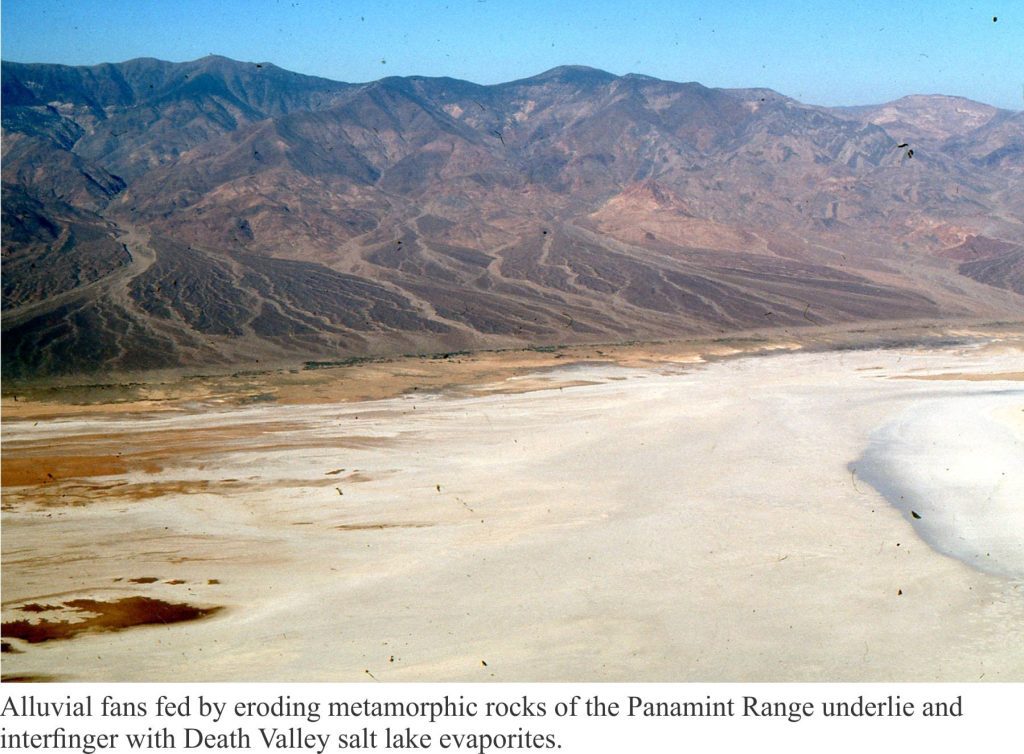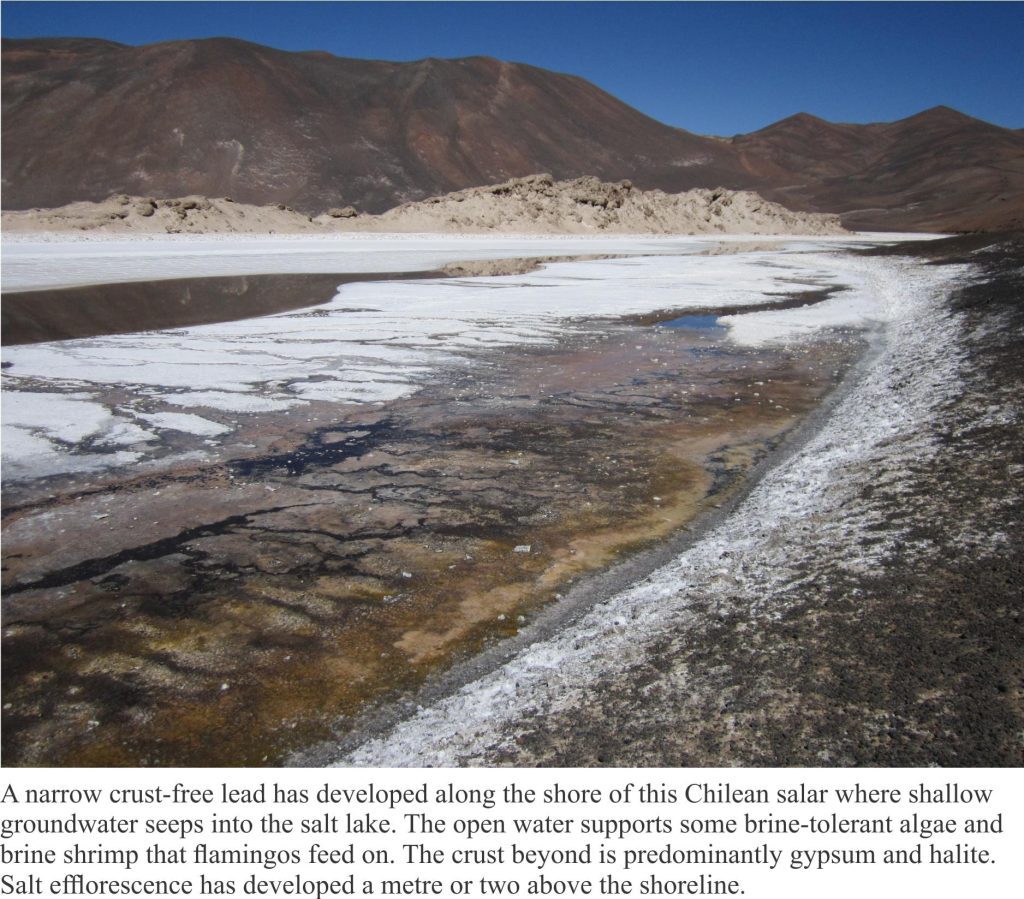Saline lake evaporites – some general physical and chemical conditions
This is part of the How To…series on evaporites
Evaporites are rocks formed by precipitation of water-soluble salts under conditions of intense evaporation. The overarching condition is that evaporation of surface waters exceeds inflow or recharge, such that mineral saturation or supersaturation is maintained. From a geological perspective this usually requires basins to be closed. This is fairly easy to visualize in small land-locked basins like salt lakes, playa lakes, and salars that are bound by topographic barriers or where surface drainage is minimal or non-existent – in such cases new water may flow into the basin but none leaves, except by evaporation (a kind of Hotel California of evaporites).
Evaporites formed in oceanic systems are quite different. Iconic examples like the Permian Zechstein Sea indicate such basins were huge. These basins must still be hydrologically ‘closed’ such that surface evaporation exceeds seawater inflow, which means that mixing of normal seawater and saturated water must be kept to a minimum. Thus, we might expect such conditions on shallow platforms that are protected by a barrier of some kind (like the Late Miocene-Pliocene Messinian Mediterranean Sea), or in deeper basins where salinity stratification is maintained. Notably, there are no modern analogues for these types of evaporite deposit.
The notes here are a brief (and incomplete) introduction to saline lake evaporites. The literature I have drawn on (below) is more encyclopedic.
Tectonics
Tectonics ultimately controls the conditions in which evaporites form: topography, climate ( humidity and precipitation), groundwater flow and surface drainage, bedrock composition and its weathering products. Tectonic-geomorphic controls on closed-basin evaporites are a lesson in contrasts:
- Australian basins, like the ephemeral Kati Thanda – Lake Eyre, or the acidic salt flats in Yilgarn, have formed on ancient, stable, deeply weathered Precambrian cratons;
- The Death Valley salt lakes occur in a region of active crustal extension – the Basin and Range Province. In northeast Africa, Magadi Lake is one of a string of salt lakes in the East African Rift.
- Dead Sea fills a pull-apart basin along the Dead Sea Transform Fault System – the lithospheric-scale strike-slip boundary between the African and Arabian plates;
- Salars of the Chilean Altiplano-Atacama region are nestled against volcanic complexes, including calderas, associated with Andean subduction.
Climate
For evaporites to accumulate, evaporation must balance or exceed water inflow from precipitation, surface runoff, or groundwater seepage. This does not mean that it can never rain in such places, but that floods or deluges must be short-lived. Even the Atacama Desert receives a few drops of rain or rare flash floods.
All evaporites occur in arid climates. We commonly associate aridity with warmth – Kati Thanda – Lake Eyre, Dead Sea and Death Valley are but three (of many) regions associated with subtropical deserts. Evaporites can also accumulate in cold, even frigid climates; good examples can be found in the Dry Valley lakes of Antarctica (common gypsum and halite) where mean annual temperatures range from -15oC to -30oC. Likewise, many salars of the Chilean Atliplano are at elevations of about 4000 m, where summer temperatures are cool and humidity is close to zero. While temperature may not determine where an evaporite deposit will form, higher temperatures do increase the rates of evaporation and mineral precipitation. Temperature will also control the local micro- and macro-biota, both of which can influence mineral precipitation and the REDOX conditions of lake waters.
Hydrology and hydrogeology
Basins that lack outgoing surface drainage are called endorheic basins. Such basins are surrounded by drainage divides and the area of drainage can be significantly greater than that of the enclosed lake. Water enters these basins as surface runoff (rain or snow melt), groundwater seepage, direct precipitation and in some cases hydrothermal flow. Except for precipitation, all these fluid inputs must contain sufficient solute. It is the balance among all these inputs against evaporation that maintains levels of mineral saturation-supersaturation or desiccation.
The elevated topography ensures that groundwater flow is towards the lake. Groundwater will exit at the shoreline and if there is sufficient hydraulic drive (depending on the amount of topographic relief) seepage may occur across the lake floor. Surface runoff, occasionally manifested as flash floods, will also deposit clastic sediment along the lake margins. For example, alluvial fans may interfinger with evaporite deposits.
Evaporite composition
Oceanic evaporites are formed from seawater, the composition of which has probably not varied much over geological time. In contrast, and as Hardie and Eugster (1970) state in one of their iconic papers on saline lakes, the “composition of brines … exhibits a bewildering range”. There is an equally impressive array of evaporite minerals – several of the publications listed below tabulate the mineral species. The original composition of saline lake waters is governed by several factors:
- Most natural waters contain plenty of Na, plus a relatively limited array of other cations and anions like K+, Ca2+, Mg2+, Cl–, SO42-, HCO3–, CO32-, and some SiO2.
- Bedrock-soil composition through which waters seep. Surface weathering and soil development, particularly soils influenced by microbes, will be strong determinants of lake water compositions. For comparison, limestones will produce calcium and carbonate rich waters with slightly elevated pH values (pH 8-9), whereas rocks containing sulphides will produce more acidic waters where HCO3– and CO32- are absent (unstable). Those having a surfeit of alkali metal carbonates (most commonly Na, K and Li) can have pH values >10. Lithium is commercially important in brines beneath several salars of Chile, Bolivia and Argentina.
- Residence time of groundwater: this is basically the time taken from infiltration at the surface, to surface seepage at some location down hydraulic gradient. Longer residence times usually give rise to higher solute concentrations.
- Hydrothermal fluid input can introduce ion species less abundant than in more local bedrock, as well as influencing lake water temperature.
- Large saline lakes may be become salinity and density stratified. Upper layers will tend to be more oxygen-rich because of regular mixing; deeper layers more anoxic. Salinity stratification is an important control on REDOX conditions throughout lake waters.
- REDOX conditions: Oxidation can play a significant role in fluid composition where sulphides are present in bedrock (commonly as mineralization). Sulphides readily oxidize to sulphate, releasing cations like iron (Fe2+ becomes Fe3+) and acidic waters (this is one of the main problems of acid-mine drainage). In larger lakes, the upper layers can support phototrophic and other organisms (e.g. algae, diatoms), that ultimately sink through the brine layer to the lake floor where decay consumes any remaining oxygen. Here, the salinity boundary acts as a chemocline, a chemical boundary, below which the redox conditions change drastically. Under these conditions, metal oxides like Fe2O3 may dissolve and any sulphate is reduced to sulphide; this may happen at or below the sediment-water interface where metal cations like Fe, Cu, Mn, Pb and Zn are stabilized as their respective sulphides. The deeper anoxic brines may also support methanogenic or anaerobic bacteria.
- Cycle of wetting and drying: Maintenance of evaporite conditions requires intense evaporation over relatively long periods. However, successive wetting and drying cycles can influence brine and mineral compositions. Under shallow conditions, wetting (e.g. rain) can dissolve some minerals and temporarily change the saturation state of lake and interstitial fluids; for example, halite dissolves readily, potentially removing Na and Cl from the site. Drying eventually results in the kind of evaporative pumping witnessed on sabkhas, moving water and solute from the watertable through the capillary zone. In larger lakes, extended dry periods may shift brine stratification boundaries in concert with lower lake levels and migrating shorelines. Brief periods of precipitation will increase mixing and oxygenation of upper lake layers, perhaps even diluting the deeper brines. Any sediment introduced to the lakes, particularly bottom-hugging sediment gravity flows, may also modify brine stratification and disturb chemoclines.
The next post deals with closed-basin brine composition and evolution
The photo of Death Valley salt polygons is from Marli Miller’s beautiful image collection.
Links to related posts
Mineralogy of evaporites: salt tectonics
Mineralogy of evaporites: Saline lake brines
Mineralogy of evaporites: Death Valley hydrology
Mineralogy of evaporites: Marine basins
Mineralogy of carbonates; classification
Mineralogy of carbonates; carbonate factories
Mineralogy of carbonates; basic geochemistry
Mineralogy of carbonates; meteoric hydrogeology
Mineralogy of carbonates: sabkhas
References
K.C. Bennison and B.B. Brown. 2015. The evolution of end-member continental waters: The origin of acidity in southern Western Australia. G.S.A. Today, v. 25, No. 6, p. 4-10.
D.M. Deocampo and B.F. Jones. 2014. Geochemistry of Saline Lakes. Treatise on Geochemistry. Elsevier, p. 437-469.
L.A.Hardie. 1991. The significance of evaporites. Annual Review Earth & Planetary Sciences, v. 19, p. 131-168. Click on the OA full text icon top right.
L.A. Hardie and H.P. Eugster, 1970. The evolution of closed basin brines. Mineralogical Society of America, Special Paper v. 3, p. 273-290. 50 years old but still an iconic paper and a must-read.
J. Warren, 2016. Evaporites. In W.M. White (Ed.) Encyclopedia of Geochemistry. Springer International, p. 1-8. Concise summary of saline lake and marine brine.




